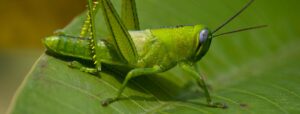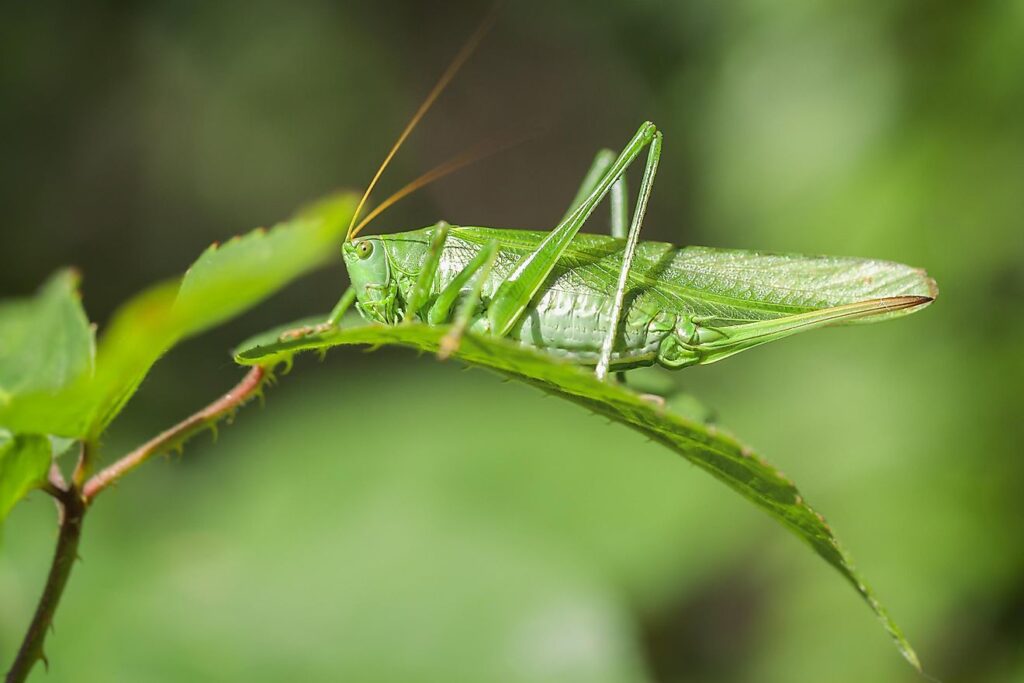What Do Grasshoppers Eat?
-by Abhrajita Mondal
–Reading Time – 7 min Approx
–Edited by – Srishti Bhattacharyya
If you manage to observe a grasshopper’s mouth under a microscope, you will be amazed. It is designed to chew on grass and plants. A grasshopper’s head is oriented downwards whereas predatory insects have their mouths oriented forward; this enables them to gobble their food or prey easily. Before we move on to discover this interesting insect’s food habits, habitat, and characteristics, let us first tell you about its position in the animal kingdom.
Before we approach the question ‘what do grasshoppers eat’ let us first learn about its biological names. Grasshoppers belong to the group Orthoptera. The sub-order is Caelifera. Short-horned grasshoppers are the most common grasshoppers. They have large hind legs so that they can jump high. The antennae are short and they have mandibles to chew their food. The other mouth part is called the maxillae. It acts as a fork and spoon.
The young grasshoppers are called nymphs. At that stage, they look like smaller versions of their parents. Moreover, their wings are not fully developed at this stage. At over eight weeks, the nymphs molt and convert into fully-grown adults. Are you also wondering, ‘what do grasshoppers drink’? You will find that out too.
What Do Grasshoppers Eat?
Grasshoppers love to gorge on a wide variety of foods. Some grasshoppers are labeled as grass-eaters and some generalists. There are still others that are recognized as Monophagous. Their feeding behavior is dependent on their preferences. Grasshoppers are herbivores. However, you will find a few which feed on dead grasshoppers too.
You will be amazed to know that a majority of grasshoppers are polyphagous. This means they rely on several varieties of plants. If the grasshoppers have a varied diet, it reflects on their health and growth. Grasshoppers that have a mixed diet grow faster. They generally feed within a certain area. Moreover, they do not like to spend much energy and travel long distances to feed. Lubber grasshoppers eat cabbage, kale, beans, pea, tomato, okra, and lettuce.
There are certain facts about grasshoppers that you should know. They feed on leaves that suit their preference. The hardness of the leaf and its size also affect the grasshopper’s feeding behavior. Additionally, the grasshopper’s diet comprises broadleaf weeds, grasses, and herbs. Moreover, grasshoppers rely on olfactory senses as well as sight, to locate their food. They have a habit of testing the plants first. The physical properties of plants are really important.
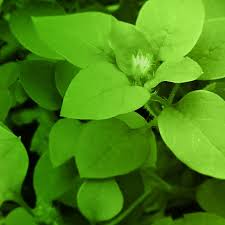
The Lubber Grasshopper is a generalist feeder. You will find it mostly in the USA. These grasshoppers are dependent on almost a hundred plants spread across thirty-eight families. You will find them feeding on ornamental plants, vegetables, and foliage. They reside on desert grasslands, oak woods, and shrub forests. Lubbers feed on cotton plants and citrus leaves as well. That answers your query, ‘what do grasshoppers eat’. Grasshoppers need something to drink, isn’t it? This might come off as a surprise, but no, they do not need water separately. They derive water from the vegetation itself.
However, a few questions still haunt inquisitive minds. You may think do grasshoppers eat bugs? No, they don’t prey on other insects. However, they do nibble on dead animals, including their own species for protein. Grasshoppers are primarily herbivores. They are an opportunistic lot. Moreover, they are highly adaptable. You will find them feeding on, whatever they can lay their hands on. The enzymes in their saliva allow them to digest dry matter as well. Some eat toxic plants too. The baby grasshoppers feed on shoots, clover, and grass. With each molt, their appetite increases.
Types of Grasshoppers:
There are more than 10,000 species of grasshoppers which are divided into two main types – long-horned and short-horned.
Long-horned grasshoppers are also referred to as bush cricket. These grasshoppers have long antennae which help to camouflage. The antennae become active at night and create a lot of noise. Almost all the members of this family are green in color. Some other long-horned grasshoppers are the Katydid, Meadow grasshopper, and the Cone-headed grasshopper.
The short-horned ones have a short but heavy antenna. These are experts at camouflage. They have long hind legs that enable them to hop long distances. Lubbers and locusts fall in this category. There are a few other types as well. It includes pygmy grasshoppers. They are brown or gray. The grasshoppers are very old creatures, aging back to around 200 million years.
Grasshopper Habitat:
Grasshoppers can be found everywhere. There are various grasshopper habitats. They can stay in rain forests as well as hot deserts. Moreover, they have funny bodies. An amazing fact is that there are 18,000 species of them worldwide. Another interesting fact about them is that they can eat food sixteen times more than their body weight.
You will find them mostly on low-lying plants and crops. They love to eat grass, crops, and leaves. Moreover, you will find them across rain forests, grasslands, pastures, agricultural fields, and also the tropics. They are rarely found in freshwater swamps and mangroves. You may be surprised to know, that they are also found in deserts. They are great at adaptation and if conditions are not suitable, they even migrate to a suitable place. They can migrate 15 miles or more per day. The rare species of grasshoppers reside in shrubby areas.
Grasshoppers love to feed on crops like barley, oats, and corn. Therefore, they are regarded as pests. The number of natural predators has increased manifold. This helps to control the grasshopper population. Many times farmers use pesticides to control this menace. The meadow grasshopper which inhabits most parts of Canada is the only species that is Nearctic. The other species are mostly Palaearctic. The meadow grasshopper spends a lot of time in meadows, tall lush grasses, and roadsides. So, you are well-acquainted with the fact about where do grasshoppers live.
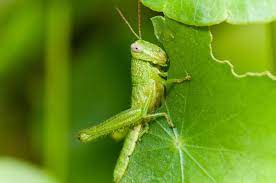
What Do Grasshoppers Eat in The Amazon Rainforest?
Now that you know where grasshoppers live, we can learn about their eating habits. Like all other animals and insects, grasshoppers residing in rainforests are brightly colored and prettier. Many types of grasshoppers reside in the rain forests. Grasshoppers are very important for the ecosystem. The reason being they provide food to carnivores. Rainforest grasshoppers feed on vegetation. They are mostly herbivores and eat plants. Grasshoppers in the Amazon rainforest come in a variety of colors. They are available in greyish-brown, rich emerald, and mustard colors as well.
They have adapted to live in the rainforest. Their legs allow them to hop a long distance which in turn allows them to avoid predators. However, not all grasshoppers have wings to fly. The grasshoppers eat cotton, clovers, oats, wheat, and other vegetation. Some even feed on toxic plants.
What Eats a Grasshopper?
Grasshoppers are an important part of the food chain. Many animals derive their nutrition from them. Frogs, toads, lizards snakes, and several birds feed on grasshoppers. The birds which feed on grasshoppers are blue jays, hawks, and bluebirds. The bigger ground beetles, bees, and wasps also feed on them. Shrews also love them in meals. Therefore, grasshoppers lay a large number of eggs to maintain the balance. Otherwise, the population of grasshoppers would have destroyed whole fields. This would have led to starvation.
There is another interesting fact for you. Humans also eat them. Mexicans and Africans eat grasshoppers for their proteins. Humans prepare grasshoppers in a variety of ways. They eat grasshoppers boiled, fried, as well as sun-dried. You can plan a trip to Thailand. They are sold skewered as roadside delicacies. Fungi also kill and feed on them. The fungi, Entomophthora grylli affects grasshoppers when they climb on the infected plants. That answers your question.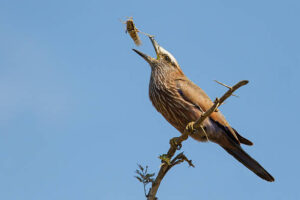
However, it is a battle out there for the Grasshoppers to defend themselves. They do not bite. So how do they defend themselves? They fly away or jump away from their predators. Their long legs are a savior in such cases. A few species have poison. Moreover, they are so colorful, it distracts predators. Grasshoppers also spit a juice or digestive enzyme, called ‘tobacco juice’. It tastes really bad and acts as a deterrent.
What Do Grasshoppers Do?
So, do grasshoppers have a purpose? Yes, they do. They play a critical role in the environment. Grasshoppers make the environment a better place for other animals and plants. They help in maintaining the natural balance. Moreover, they also facilitate decomposition and regrowth. Furthermore, they help maintain parity in the environment, by consuming other plants.
Their waste is a good fertilizer. The grasshoppers are small in size. When they die, their bodies decompose easily. It is also the base of the food chain. Many primary consumers and secondary consumers in the food chain are dependent on them. If the grasshoppers do not provide enough energy, the chain will collapse. They also help in crop management.
Now, you know so many interesting facts about grasshoppers. You can probably identify them, in the garden or the park. And, the next time you hear chirping noises at night, don’t get scared. They are the friendly crickets. What grasshoppers eat and excrete is an important part of the ecosystem. That makes them very essential for our survival.
-by Abhrajita Mondal
Dear Reader, Hope you liked the post. If you think our initiative “The Creative Post” is worth supporting, then please support us by paying the amount you think we are worthy of. We believe, the value of content should be decided by the consumer. Hence we request you to evaluate our worth and pay accordingly by Clicking Here.
